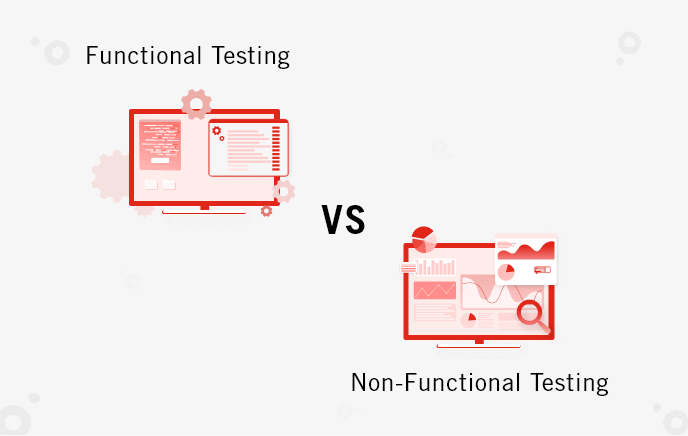Quality Assurance (QA) is a key part of the software development lifecycle, and there are a variety of testing methods based on the kind of application being developed or the component that needs to be tested. Similarly, there are many testing processes that can be automated, which is essential for organizations adopting DevOps, and some that are difficult to automate and need to be done manually.
Software testing can broadly be categorized into two types of testing: Functional Testing and Non-Functional Testing. Functional Testing focuses on setting up standard QA practices to ensure that your software does exactly what it is designed to do while Non-Functional Testing is deployed to ensure optimal performance and security.
Let’s take a look at the differences between Functional and Non-Functional Testing with key considerations of each.
What to Explore
Functional Testing
At its simplest form, Functional Testing does just what its name implies: tests the software or a component of the software to ensure it is functioning as expected. Functional Testing can apply to web and mobile applications; responsive user interfaces (UI); software designed using service-oriented architecture (SOA), APIs and microservices; as well as ETL and BI Reporting applications.
More and more, Functional Testing is being automated to overcome today’s impending software challenges (i.e. requirements capturing, selecting the right tools, honing the skillsets of QA analysts, and proper enhancement of regression suite and maintenance).
When establishing Functional Test automation practices, QA managers should consider the following areas:
- Holistic feasibility study to analyze automation
- Test Automation Frameworks (Keyword, Data, and Hybrid) which can be reused for different Web and mobile applications (Native, Hybrid, and Web)
- Reduction in Testware development time and effective maintenance
- Testing with Cloud-based tools to enhance test efficiency and reducing Testware development time
- Cloud-based testing on a variety of browsers for Web and devices for Mobile apps, with a variation in operating systems providing efficient coverage of real-usage scenarios
- Responsive UI layout testing on a wide range of browsers and devices
- Acceptance Test Automation using behavior-driven development tools
- The exploitation of Open Source tools/APIs to generate cost-effectiveness
- Reduction in time to market and effective ROI
- Adherence to best practices and best QA tools available
Leading open-source and commercial tools for Functional Testing include the following.
Web, Desktop and API Automation
Commercial Tools: TestComplete, UiPath, TOSCA
Open Source Tools: Katalon Studio
Mobile Automation
Commercial Tool: Perfecto
Open Source Tool: Appium
Non-Functional Testing
Non-Functional Testing applies to areas outside the functionality of the software but are essential for the software’s performance. As such, Non-Functional Testing typically covers areas like performance testing, load testing and vulnerability (or security) testing.
Market trends in testing are quickly moving toward non-functional testing, as organizations become more aligned towards getting their applications to meet specific performance/security criteria before deploying into the “real” world. The best solutions aim at exploiting open source tools to build robust and distributed performance test suites, which simulate realistic user loads helping to discover bottlenecks before the application goes live.
When establishing Non-Functional Test practices, QA managers should consider the following areas:
- Creation of Web/mobile app performance tests after analyzing usage patterns
- Optimization of performance tests using API and scripting of Open Source tools
- Leveraging Cloud-testing tools to simulate higher loads and realistic geographic loads from different geographies
- Simulation of loads from various browsers for Web applications
- Mobile performance testing on various networks Edge, 3G, 4G, LTE, etc.
- Distributed load testing to simulate higher and realistic user loads
- Generation of easily comprehensive load test reports, which act as a critical input to analyzing application performance
- Analysis of application performance per page and server request/response analysis before it is productionized
- Considering all the parameters for performance testing for Web applications (i.e. server, pages, and HTTP request/responses), hence providing a thorough insight into the performance of the application
- Generating test reports which are easily readable by key stakeholders
- Surveillance of Web applications for present vulnerabilities
- Penetration of vulnerabilities discovered
- Knowledge of prominent APIs/tools to develop strong test suites
- Development of custom Test Suite for Security Testing
- Coverage for the discovery of standard vulnerabilities enlisted by OWASP
Leading open-source and commercial tools for Non-Functional Testing include the following.
Performance Test Automation
Commercial Tool: Load Runner, NeoLoad
Open Source Tools: Apache Jmeter
Security/Penetration Testing
Commercial Tool: Burpsuite
Open Source Tool: Kali Linux
The Future of Testing
This article provides a brief introduction to the world of Functional and Non-Functional Testing. There is a wide array of commercial and open-source tools in the market to address specific kinds of testing requirements or to help build out an enterprise test automation framework to fit with Agile and DevOps testing strategies.
Whether just starting the process to implement testing practices or advancing your capability to a fully automated testing framework, Functional and Non-Functional Testing are both essential to delivering the best quality software in today’s competitive environment. Keeping ahead of changing industry trends, Bitwise is well versed in providing test automation tools, technology, and capabilities to enable the perfect testing strategy for your company’s needs. See our Performance and Mobile Testing page to explore further.
You Might Also Like


Data Security
Implementing Fine-Grained Data Access Control: A Complete Guide to GCP Column-Level Policy Tags
Learn More








